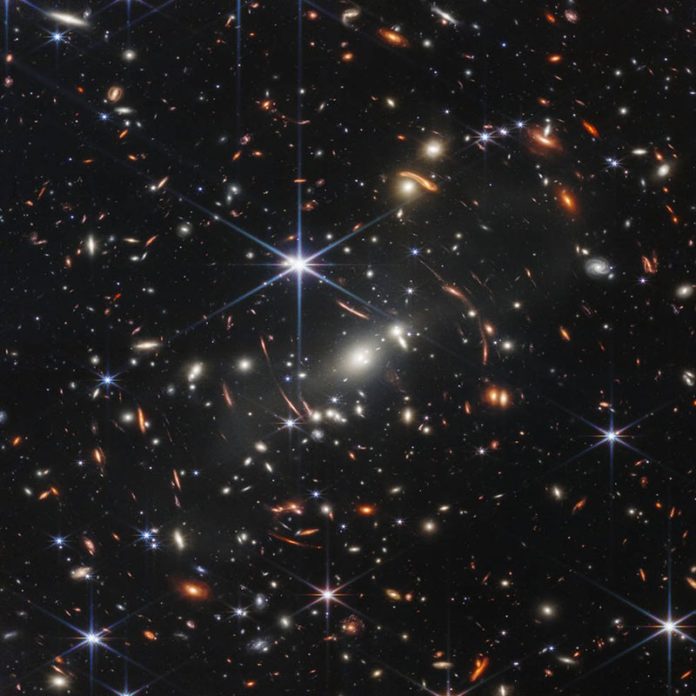The wait is over. The first scientific image from NASA’s James Webb Space Telescope has dropped, and astronomers are mesmerized. US President Joe Biden released the historic picture, which is the deepest astronomical image of the distant Universe, during a press conference at the White House on Monday. NASA will publish more images on 12 July.
The first image, closely guarded before the reveal, showcases the telescope’s transformational capabilities. It shows thousands of distant galaxies in the constellation Volans, fainter than any galaxies seen before, in a patch of sky no larger than that covered by a grain of sand held at arm’s length.
It shows “the oldest documented light in the history of the Universe, from over 13 billion — let me say that again — 13 billion years ago”, said Biden when releasing the image. “It’s hard to even fathom.”
“I’m just amazed,” says Vivian U, an astronomer at the University of California, Irvine. “I’m just panning through the image, figuring out what all the smudges are and why they’re there.”
Scientists expect Webb, the largest telescope ever launched into space, to revolutionize the study of the cosmos. The first batch of images to be released, including the deep-field shot, has been selected to encompass all of the observatory’s major scientific targets: the early Universe, the evolution of galaxies and stars, and planets beyond the Solar System.
A transformational telescope
Unlike the Hubble Space Telescope — one of the largest and most famous space telescopes — Webb detects mainly infrared wavelengths. By studying infrared light, it can penetrate the clouds of dust that obscure newborn stars and can peer farther into the cosmos than ever before. Webb “is not Hubble version 2 — it’s really a very different telescope”, says Zolt Levay, a retired astronomer and image processor who worked for decades on Hubble imagery. “It’s invisible light that we’re looking at.”
Galaxies that lie very far from Earth can be seen only in infrared wavelengths, because the expansion of the Universe has shifted their light out of the visible part of the electromagnetic spectrum and into the infrared. Webb’s first deep-field image shows this effect dramatically around a cluster of galaxies known as SMACS 0723, which lies around 4 billion light-years from Earth. The clusters’ gravity bends and magnifies the light of objects behind it, allowing astronomers to glimpse extremely distant objects.
“The things that are catching my eye are the distorted galaxies,” says Lisa Dang, an astronomer at McGill University in Montreal, Canada. “They look like no other galaxies that we know of.”
Webb’s first image shows galaxies that might date back more than 13 billion years, nearly all of the way to the Big Bang that created the Universe 13.8 billion years ago. It calls to mind several iconic deep-field images taken by Hubble. The first of those, made over the course of 10 days during the Christmas holidays in 1995, revealed that a seemingly empty patch of sky was dotted with thousands of previously unseen galaxies. Webb’s first image took just 12.5 hours to compile, compared with the weeks it took Hubble to observe other deep fields.
Webb also specializes in spectroscopy, the study of how light at various wavelengths interacts with matter. The infrared spectra of astronomical objects that Webb will produce can reveal what the objects are made of chemically — to a degree that images cannot. “That’s where some of the really exciting science will happen,” says Elizabeth Kessler, a historian at Stanford University in California who has studied the aesthetic impact of Hubble imagery.
Webb’s first scientific images come as something of a catharsis for the telescope project, which has suffered from years of delays and billions of dollars in cost overruns. Initially envisioned in 1989, Webb ultimately cost NASA nearly US$10 billion. It is the most complex space observatory ever built. Its 6.5-metre-wide primary mirror had to launch folded up, and then open like a butterfly spreading its wings, through a series of anxiety-inducing manoeuvres. Engineers had to test its tennis-court-sized sunshield — made of gossamer-thin layers of aluminium-coated polymer film — multiple times to be sure that it would unfurl properly and then protect the telescope’s instruments in the deep freeze of outer space.
NASA’s partners, the European and Canadian space agencies, contributed approximately another $1 billion in total to make the telescope a reality. Webb ultimately launched in December 2021 and spent six months readying its instruments for science; it is expected to operate for at least 20 years.
The world is watching
Webb is named after James E. Webb, who ran NASA during the height of the Apollo Moon-exploration programme in the 1960s. Some astronomers have called for the telescope to be renamed, given that James Webb held a prominent leadership role at the US State Department in the late 1940s and early 1950s, when the department was at the forefront of the US government’s effort to identify and fire gay and lesbian employees. NASA has said that it has no evidence to warrant changing the telescope’s name. Its acting chief historian, along with another historian, continue to research the issue and are expected to release a report on their findings soon.
The first images from Webb represent only a sliver of the science it will make possible. They were taken over just 120 hours of observation during the past few weeks. Upcoming studies include explorations of the planets Jupiter and Saturn, of small faint stars known as red dwarfs, of distant galaxies that are colliding with one another and of hot rocky planets around other stars. U, who has observing time on Webb, is already anticipating getting her first data from the telescope on Thursday. That’s when the Webb team will upload observations of galaxy mergers to a website for her and her colleagues to access.
Levay remembers working on some of Hubble’s most iconic image releases, such as the publication of pictures taken after astronauts visited the Earth-orbiting telescope to upgrade its instruments. “You know the whole world’s watching, and that you’d better deliver,” he says.
Webb seems to have done just that. “It’s working better than I think anybody expected,” Levay says. “And that’s great.”








